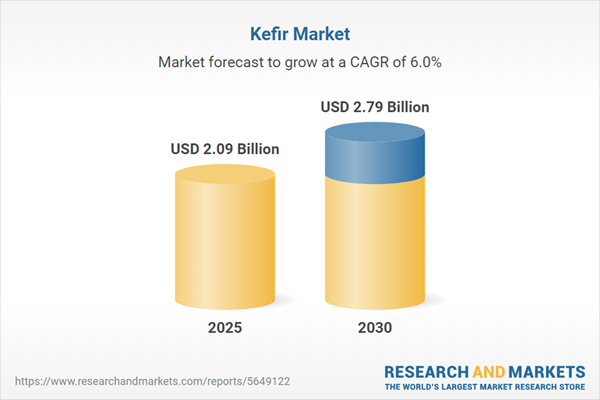Kefir is a fermented drink prepared from kefir grains that taste like a thin yogurt. Kefir products are made with freshwater or fermented milk, as well as kefir grains cultivated with bacteria and yeast. Kefir goods include kefir milk, smoothies, probiotic drinks, yogurt, and organic kefir drinks. These products are high in vitamins, minerals, protein, calcium, and magnesium.
Furthermore, the kefir sector increases as people's choices for healthy snacks and drinks change. Kefir products are high in nutrients and aid in improving one's health and immunity. It has several health benefits, including enhanced digestion and bone and skin health. It also has antifungal and antibacterial characteristics that help cure and prevent vaginal and gastrointestinal infections, as well as food-borne pathogens. It also possesses anticarcinogenic effects, which aid in the early stages of tumor progression. As a result, during the forecast period, these considerable benefits will force the kefir market ahead.
Kefir market drivers:
The global food and beverage business has been primarily driven by natural products
Kefir is a probiotic-rich beverage produced from milk and fermented kefir grains. It's high in vitamins and minerals, and it's a fantastic source of protein as well. Vitamin K, B12, calcium, biotin, enzymes, vitamin B9, and other nutrients necessary for optimal human function are abundant. It has enough germs to help the digestive system function properly. Kefir helps to boost your immune system while also lowering your cholesterol levels.It also aids in the control of blood sugar levels and the loss of weight. Because of the wide range of probiotics and increased bioavailability, the fermentation process boosts the health benefits of food. Organic and natural products are becoming increasingly popular these days. Natural and organic items are getting more popular as consumers become more health-conscious. The rapid adoption of new lifestyle trends that are predicted to boost demand for healthy consumption is expected to take place. This would be aided by the rising availability of disposable income, making it easier to migrate from traditional ways of life to urban lives.
The kefir market is segmented into five regions worldwide:
By geography, the kefir market is segmented into North America, South America, Europe, the Middle East and Africa, and Asia-Pacific. The major economies like China, Japan, India, and South Korea dominate the Asia-Pacific region. Some of the fastest-growing emerging economies are from this region, such as ASEAN countries.The Asia-Pacific region is expected to see notable growth in the dairy sector. In FY2,022-23, India was the world's biggest dairy industry in milk production; India produced nearly 230.58 million tonnes of milk. This is close to 50% more than the US and more than three times to China. These increased productions of milk in the country are propelling the demand for dairy products, including kefir products, in the market.
Reasons for buying this report:
- Insightful Analysis: Gain detailed market insights covering major as well as emerging geographical regions, focusing on customer segments, government policies and socio-economic factors, consumer preferences, industry verticals, other sub-segments.
- Competitive Landscape: Understand the strategic maneuvers employed by key players globally to understand possible market penetration with the correct strategy.
- Market Drivers & Future Trends: Explore the dynamic factors and pivotal market trends and how they will shape up future market developments.
- Actionable Recommendations: Utilize the insights to exercise strategic decision to uncover new business streams and revenues in a dynamic environment.
- Caters to a Wide Audience: Beneficial and cost-effective for startups, research institutions, consultants, SMEs, and large enterprises.
What do businesses use our reports for?
Industry and Market Insights, Opportunity Assessment, Product Demand Forecasting, Market Entry Strategy, Geographical Expansion, Capital Investment Decisions, Regulatory Framework & Implications, New Product Development, Competitive IntelligenceReport Coverage:
- Historical data & forecasts from 2022 to 2030
- Growth Opportunities, Challenges, Supply Chain Outlook, Regulatory Framework, Customer Behaviour, and Trend Analysis
- Competitive Positioning, Strategies, and Market Share Analysis
- Revenue Growth and Forecast Assessment of segments and regions including countries
- Company Profiling (Strategies, Products, Financial Information, and Key Developments among others)
The Kefir Market is segmented and analyzed as below:
By Nature
- Conventional
- Organic
By Type
- Dairy-Based
- Non-Dairy Based
By Application
- Food & Beverage
- Nutraceuticals
- Pharmaceuticals
- Others
By Distribution Channel
- Offline
- Online
By Geography
- North America
- South America
- Europe
- Middle East and Africa
- Asia-Pacific
Table of Contents
Companies Mentioned
- Aqua De Madre
- Biotiful Dairy
- COYO Pvt Ltd
- GT’s Living food
- KeVita.com
- Lifeway Foods, Inc
- Odysea ltd
- Fresh Made Dairy
- Nestle SA.
- Danone
Table Information
| Report Attribute | Details |
|---|---|
| No. of Pages | 134 |
| Published | December 2024 |
| Forecast Period | 2025 - 2030 |
| Estimated Market Value ( USD | $ 2.09 Billion |
| Forecasted Market Value ( USD | $ 2.79 Billion |
| Compound Annual Growth Rate | 6.0% |
| Regions Covered | Global |
| No. of Companies Mentioned | 10 |









